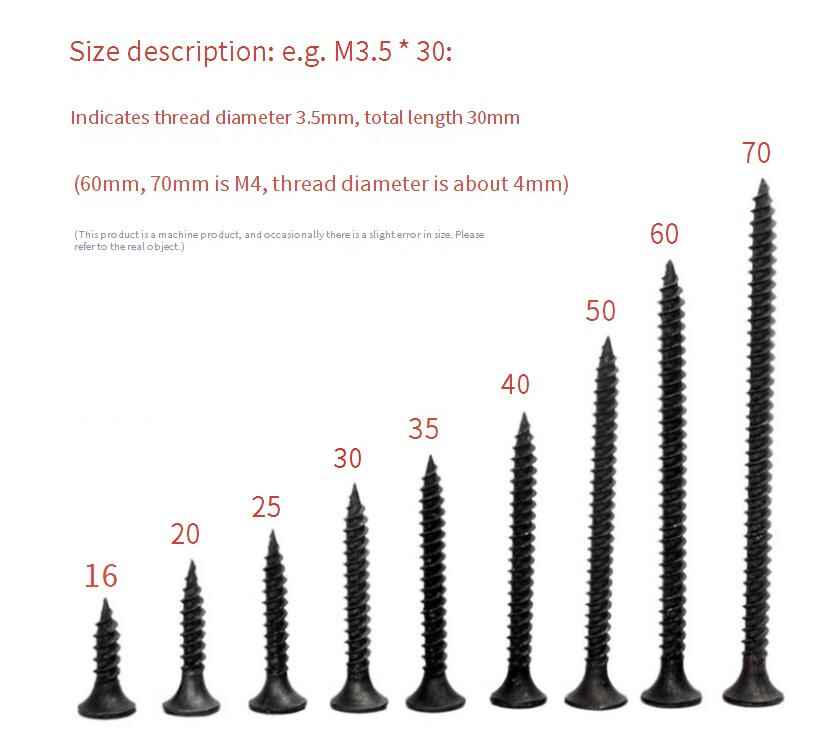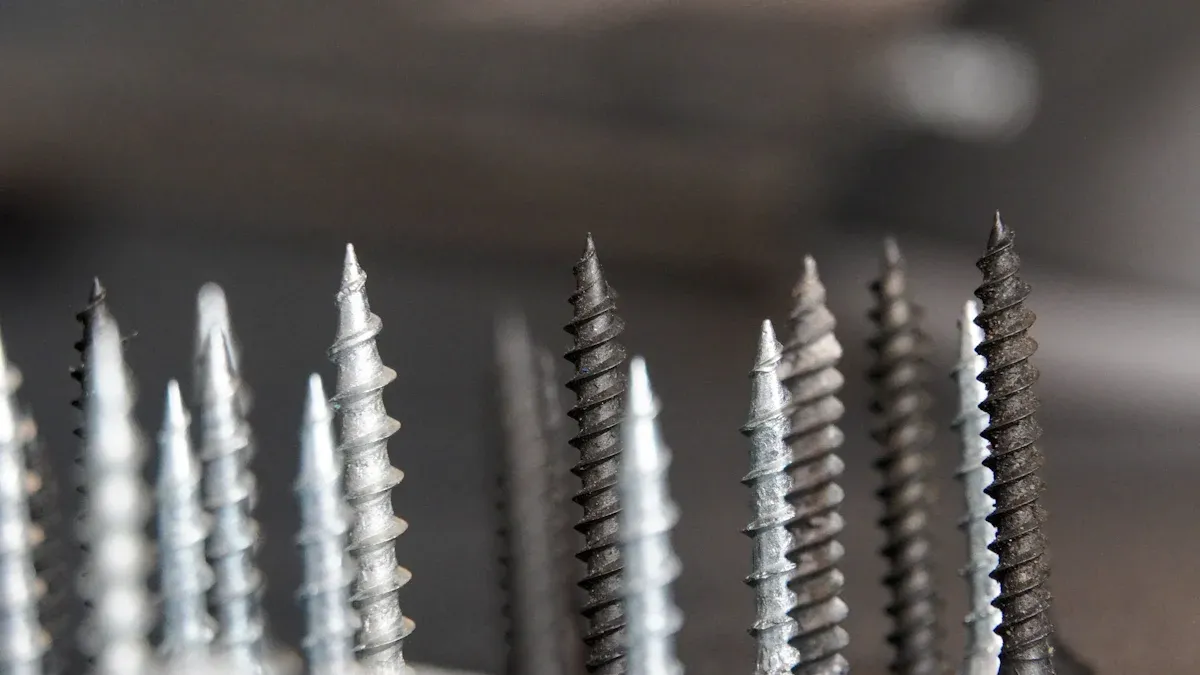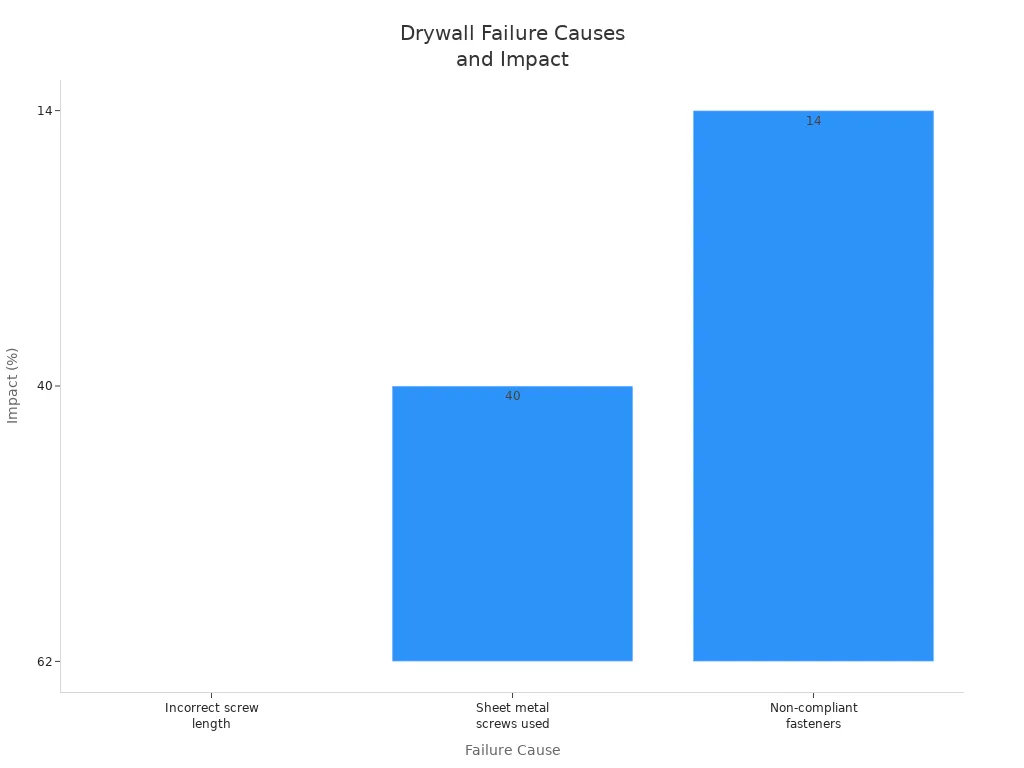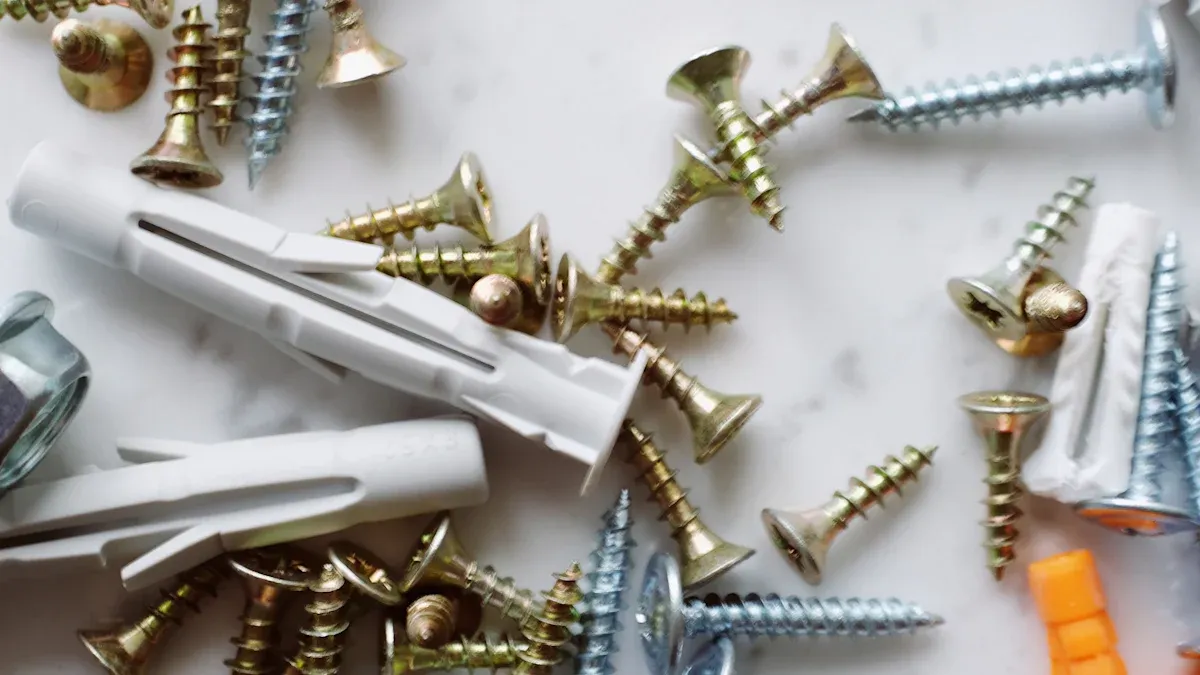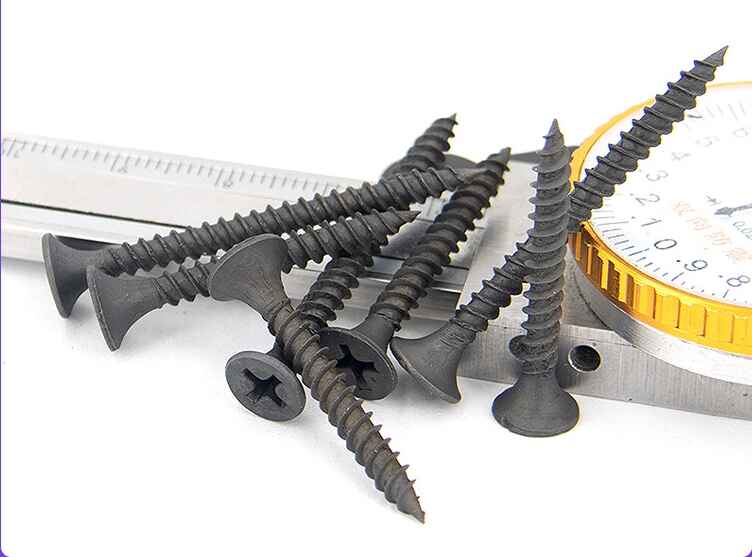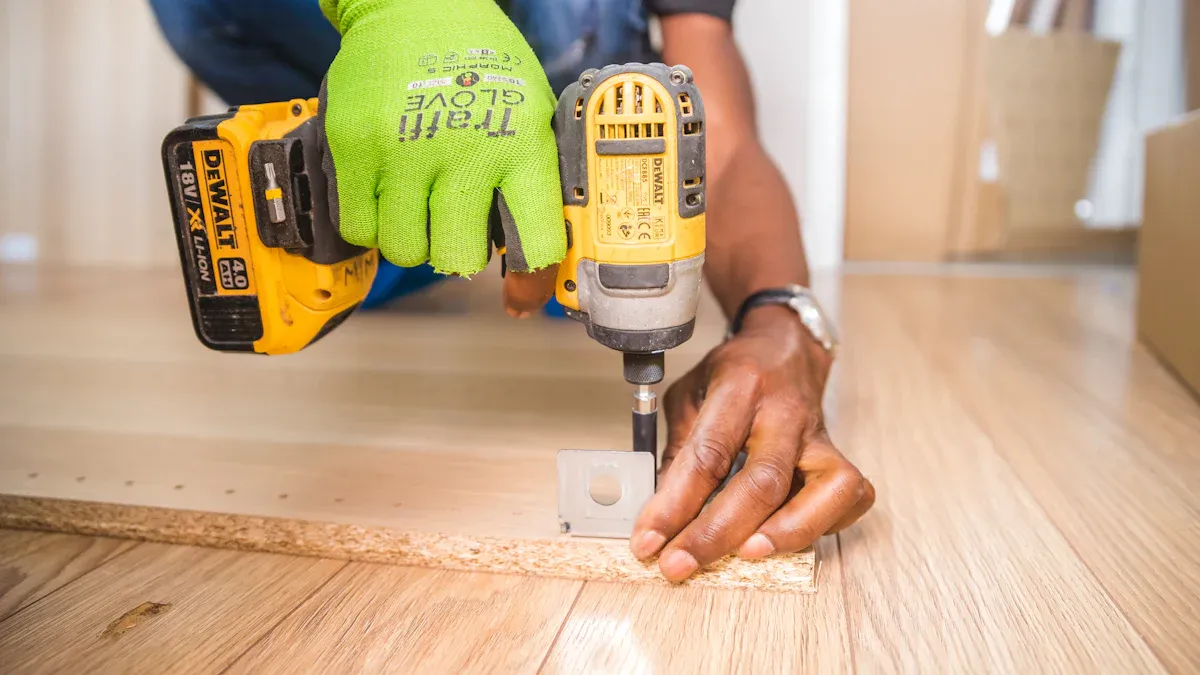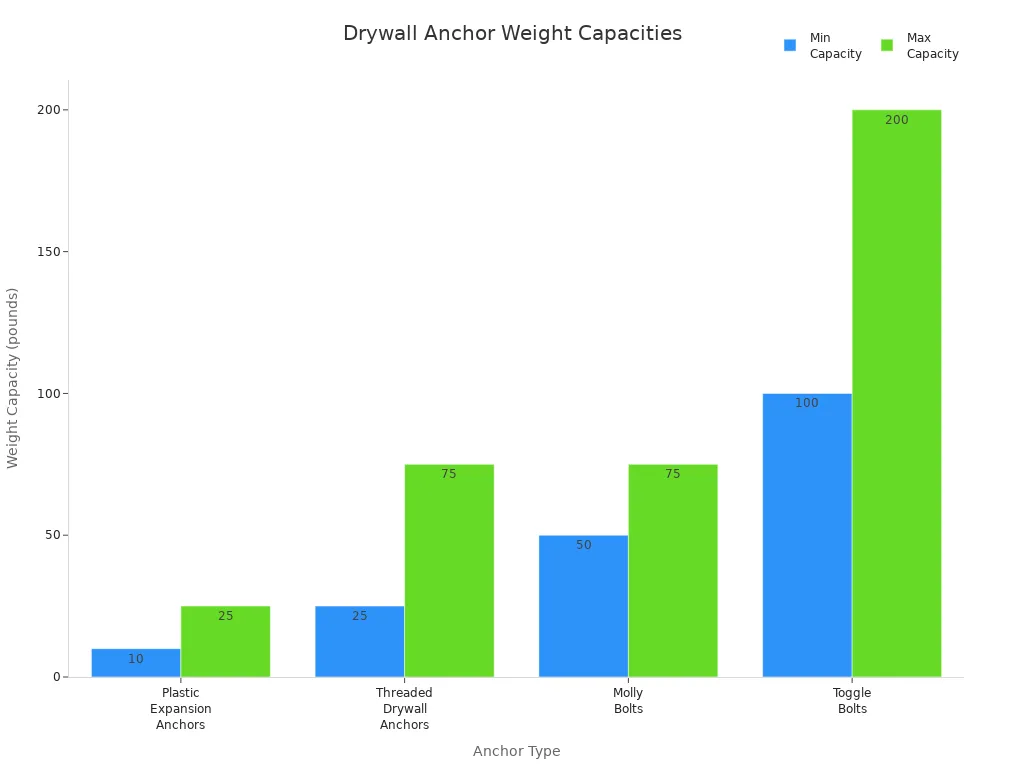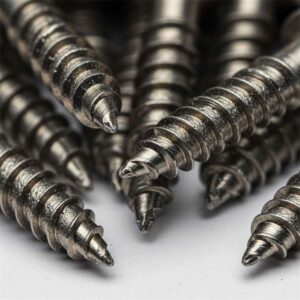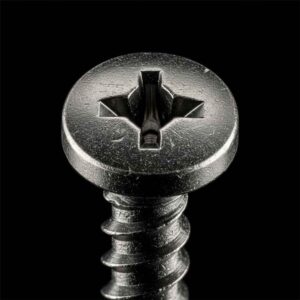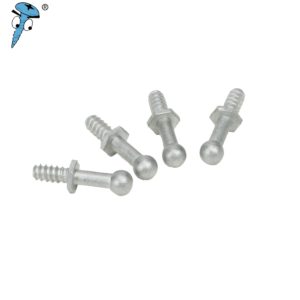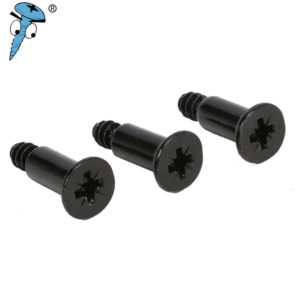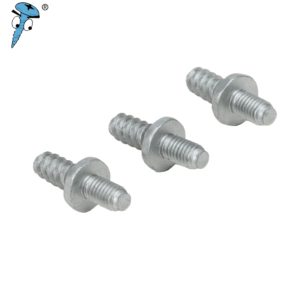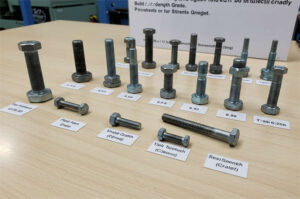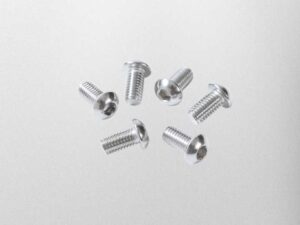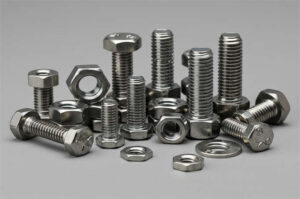You need the right drywall screw size to keep your walls strong and safe. For most home projects, use this table to match drywall thickness and stud type:
| Drywall Thickness | Stud Type | Common Screw Size |
|---|---|---|
| 1/2 inch | Wooden studs | 1 1/4 inch screws |
| 1/2 inch | Metal studs | 1 inch screws |
| 5/8 inch | Wooden studs | 1 5/8 inch screws |
| 5/8 inch | Metal studs | 1 1/4 inch screws |
Using the wrong screw causes 62% of drywall failures.
Key Takeaways
- Choose drywall screws based on drywall thickness and stud type to ensure strong, secure walls.
- Use coarse-thread screws for wood studs and fine-thread screws for metal studs for the best grip.
- Always make sure screws penetrate at least 1/2 inch into the stud to prevent sagging or popping.
- Select corrosion-resistant screws like stainless steel for moist areas to avoid rust and damage.
- Follow proper screw spacing and depth during installation to keep drywall panels tight and smooth.
Drywall Screw Size Guide
Size Chart
Choosing the right drywall screw size helps you build strong, safe walls and ceilings. You need to match the screw length to the drywall thickness and the type of stud. The table below gives you a quick reference for the most common drywall projects:
| Drywall Thickness | Stud Type | Recommended Screw Length | Minimum Stud Penetration |
|---|---|---|---|
| 1/2 inch | Wood | 1 1/4 inch | 1/2 inch |
| 1/2 inch | Metal | 1 inch | 1/2 inch |
| 5/8 inch | Wood | 1 5/8 inch | 1/2 inch |
| 5/8 inch | Metal | 1 1/4 inch | 1/2 inch |
🛠️ Tip: Always make sure your drywall screw goes at least 1/2 inch into the stud. This helps keep the drywall secure and prevents sagging or popping.
Industry guidelines recommend using 1 1/4-inch screws for attaching 1/2-inch drywall to wood studs. This length gives you enough grip without sticking out the other side of the stud. For metal studs, use 1-inch fine-thread screws for 1/2-inch drywall. Fine threads grip the thin metal better than coarse threads. For 5/8-inch drywall, professionals often use 1 5/8-inch screws on wood studs, especially for ceilings, because the extra length helps hold the heavier board in place.
Building codes require that drywall screws penetrate the stud by at least 1/2 inch. This rule ensures your drywall stays firmly attached and resists movement over time. Some codes may ask for even deeper penetration, especially for fire-rated or load-bearing walls.
Fast Answers
You may wonder, “What size drywall screws for 1/2 drywall?” or “What size screws for 1 2 inch drywall?” Here are quick answers for your next project:
- For 1/2-inch drywall on wood studs, use 1 1/4-inch coarse-thread drywall screws.
- For 1/2-inch drywall on metal studs, use 1-inch fine-thread drywall screws.
- For 5/8-inch drywall on wood studs, use 1 5/8-inch coarse-thread screws. This is especially important for ceilings.
- For 5/8-inch drywall on metal studs, use 1 1/4-inch fine-thread screws.
Quick facts:
- The size of a drywall screw depends on both the drywall thickness and the stud material.
- Coarse-thread screws work best for wood studs. Fine-thread screws are better for metal studs.
- Always check local building codes for special requirements, especially for fire-rated walls or ceilings.
📋 Note: If you ask, “What size drywall screws for 5 8 drywall?”—the answer is usually 1 5/8-inch screws for wood studs and 1 1/4-inch screws for metal studs.
Using the right drywall screw size keeps your installation strong and helps you avoid problems like loose panels or screw pops. If you follow these guidelines, you will have a sturdy, long-lasting wall or ceiling.
Why Size and Type Matter
Strength and Longevity
Choosing the right drywall screw size and type makes your walls and ceilings last longer. When you use the correct screw length for your drywall thickness, you get strong holding power. For example, if you ask, “what size drywall screws for 1/2 drywall?” you should use 1 1/4-inch screws for wood studs. This length gives you enough grip and keeps panels from sagging or popping. Coarse threads work best for wood framing because they dig deep and hold tight. Fine threads suit metal studs, giving a secure fit without slipping.
You also need to think about the environment. In bathrooms or basements, moisture can cause screws to rust. Using galvanized or stainless steel screws helps prevent corrosion and keeps your drywall strong for years. High-quality screws reduce the risk of failure and lower maintenance needs. Specialty screws, like self-drilling types, make fastening easier and improve performance, especially with metal studs.
- Correct screw length matches drywall thickness for proper grip.
- Coarse threads hold better in wood; fine threads work best in metal.
- Moisture-resistant screws prevent rust and increase longevity.
- Specialty screws save time and boost fastening quality.
Risks of Wrong Choice
Using the wrong size of a drywall screw or the wrong type can lead to many problems. If you use screws that are too short, your drywall may loosen or bulge. Screws that are too long can poke through and damage the structure. If you wonder, “what size screws for 1 2 inch drywall?” remember that the answer depends on both the drywall thickness and the stud material.
| Common Problem | Explanation | Impact |
|---|---|---|
| Incorrect screw length | Too short or too long screws weaken the installation | Loose panels, bulges, or damage |
| Wrong thread type | Coarse threads slip in metal; fine threads slip in wood | Reduced grip and stability |
| Ignoring corrosion resistance | Non-galvanized screws rust in humid areas | Premature failure and costly repairs |
| Not matching load requirements | Weak screws cannot hold heavy panels | Structural collapse or cracks |
Overdriving screws can tear the drywall paper, causing cracks or screw pops. Underdriving leaves bumps that make finishing harder. Using coarse-thread screws on metal studs leads to slippage and poor holding. If you ask, “what size drywall screws for 5 8 drywall?” you should use 1 5/8-inch screws for wood studs and 1 1/4-inch screws for metal studs. Always match the screw to the job for a safe, long-lasting result.
🛑 Tip: Always check the recommended drywall screw size for your project. The right choice keeps your walls strong and helps you avoid costly repairs.
Drywall Screw Types
Coarse vs. Fine Thread
You need to choose the right thread type for your drywall project. Coarse-thread screws and fine-thread screws work best in different situations. Coarse threads grip wood studs tightly and make installation easier. Fine threads fit metal studs and help prevent damage to the metal.
Here is a table to help you compare coarse-thread and fine-thread drywall screws:
| Aspect | Coarse-Thread Drywall Screws | Fine-Thread Drywall Screws |
|---|---|---|
| Thread Design | Wider, more pronounced threads | Narrower, closely spaced threads |
| Material Compatibility | Optimized for wood studs; strong grip without pre-drilling | Designed for metal studs; secure fit, reduces damage |
| Holding Power | Superior in wood; strong grip for long-term stability | Adequate in metal; optimized for metal penetration |
| Ease of Installation | Faster installation; fewer rotations needed; user-friendly | Requires more effort; may need pre-drilling in metal |
| Environmental Use | Often corrosion-resistant coatings; suitable for outdoor use | Phosphate coating; better for indoor, smooth finish |
| Ideal Use Cases | Residential construction with wood framing; outdoor projects | Commercial construction with metal framing; thin drywall |
| Surface Finish | May cause slight bulging; less smooth finish | Less likely to bulge; smoother drywall surface |
| Load-Bearing Capacity | Better for heavy loads in wood | Suitable for metal framing; less ideal for heavy wood loads |
| Installation Tips | Use consistent pressure; appropriate torque settings | Drill pilot holes in metal; use self-tapping points |
📝 Tip: Use coarse-thread screws for wood studs and fine-thread screws for metal studs. This choice gives you the best grip and finish.
If you ask, “what size drywall screws for 1/2 drywall?” or “what size screws for 1 2 inch drywall?” remember that coarse-thread screws work best for wood, while fine-thread screws suit metal. The size of a drywall screw also depends on the stud material.
Type W, S, and Self-Drilling
Drywall screws come in different types. You need to match the screw type to your stud material for the strongest hold.
| Screw Type | Defining Features | Best Use Cases |
|---|---|---|
| Type W (Coarse Thread) | Longer, thinner screws with coarse threads | Attaching drywall to wood studs; strong grip |
| Type S (Fine Thread) | Fine threads with sharp points | Attaching drywall to light metal studs |
| Self-Drilling | Drill bit end eliminates pre-drilling | Installing drywall onto heavy metal studs |
- Type W screws have coarse threads. You use them for wood studs. They grip wood tightly and help prevent panels from loosening.
- Type S screws have fine threads and sharp points. You use them for light metal studs. They drive easily into metal and reduce the risk of stripping.
- Self-drilling screws have a drill bit tip. You use them for heavy metal studs. They create their own hole, saving you time and effort.
💡 Note: For 5/8-inch drywall, you need longer screws. If you wonder “what size drywall screws for 5 8 drywall,” use 1 5/8-inch coarse-thread screws for wood studs and 1 1/4-inch fine-thread screws for metal studs.
Proper penetration depth matters. Type W screws should go about 0.63 inches into wood. Type S screws should go about 0.38 inches into metal. This depth keeps your drywall secure.
Head and Point Designs
Drywall screws have different head shapes and point designs. These features affect how easy it is to install the screw and how well it holds the drywall.
- Bugle head screws have a cone-like shape. They prevent tearing of the drywall paper and sit flush with the surface. This design gives you a smooth finish and strong hold.
- Trim-head screws have small, flat heads. You use them for attaching wood trim over drywall. They help hide the screw and improve the look.
- Sharp point screws start easily in drywall paper. They make installation faster and reduce slipping.
- Self-drilling points combine drilling and fastening. You use them for heavy metal studs. They speed up installation and improve stability.
- Countersunk heads allow screws to sit flush with the drywall. This feature improves the finish and holding power.
🛠️ Tip: Choose the right head and point design for your project. Bugle heads work best for most drywall jobs. Self-drilling points save time on metal studs.
When you select the right drywall screw size, type, and head design, you make your installation stronger and easier. You avoid problems like bulging, tearing, or loose panels. Always match the screw to your stud material and drywall thickness for the best results.
Choosing Gauge and Length
Screw Gauge
Selecting the right screw gauge helps you build strong walls and ceilings. The gauge refers to the diameter of the screw. Most drywall projects use #6 or #8 gauge screws. You should match the gauge to the drywall thickness and the type of stud. If you use a screw gauge that is too large, you risk cracking the drywall. If the gauge is too small, the screw may pull out and fail to hold the panel.
Here is a table to help you choose the correct gauge for your project:
| Drywall Thickness | Stud Material | Thread Type | Recommended Screw Gauge | Recommended Screw Length |
|---|---|---|---|---|
| 1/2 inch | Wood | Coarse | #6 or #8 | 1 1/4 inch |
| 1/2 inch | Metal | Fine | #6 | 1 inch |
| 5/8 inch | Wood | Coarse | #6 or #8 | 1 5/8 inch |
| 5/8 inch | Metal | Fine | #6 | 1 1/4 inch |
🛠️ Tip: Use #8 gauge screws for thicker drywall or ceiling installations. These screws offer extra strength and reduce the risk of sagging.
When you ask, “what size drywall screws for 1/2 drywall,” you should consider both the gauge and the length. Fine thread screws with the right gauge work best for metal studs. Coarse thread screws with #6 or #8 gauge are ideal for wood studs.
Length Selection
The length of a drywall screw depends on the drywall thickness and the stud material. You need enough length for the screw to pass through the drywall and penetrate the stud. For 1/2-inch drywall, use screws that are at least 1 1/4 inches long. This length ensures the screw goes at least 1/2 inch into the stud, which keeps the panel secure.
If you wonder, “what size screws for 1 2 inch drywall,” always choose screws that meet the minimum penetration requirement. For 5/8-inch drywall, use 1 5/8-inch screws for wood studs and 1 1/4-inch screws for metal studs. This guideline answers the common question, “what size drywall screws for 5 8 drywall.”
- Use longer screws for ceilings or thicker panels.
- Avoid screws that are too short, as they may not hold the drywall.
- Do not use screws that are too long, which can damage the stud or drywall.
📋 Note: The size of a drywall screw affects how well your wall holds up over time. Always check the recommended drywall screw size for your project.
Choosing the right gauge and length helps you avoid problems like cracking, screw pull-out, or sagging panels. You build safer and longer-lasting walls when you follow these guidelines.
Installation Tips
Screw Spacing
Proper screw spacing keeps your drywall secure and prevents sagging or cracks. For walls, place screws about 8 inches apart along the edges and 16 inches apart in the center, matching the stud spacing. Ceilings need more support, so space screws 7 to 8 inches apart at the edges and about 12 inches apart in the field. This pattern helps the drywall resist gravity and extra weight, such as insulation. Always keep screws at least 3/8 inch from the edge of the drywall sheet. This distance stops the edge from breaking and gives each drywall screw a strong hold.
| Drywall Section | Recommended Screw Spacing |
|---|---|
| Wall Edges | 8 inches apart |
| Wall Field (center) | 16 inches apart |
| Ceiling Edges | 7–8 inches apart |
| Ceiling Field | 12 inches apart |
🛠️ Tip: Use about 32 screws for each 4×8 foot drywall sheet on walls.
Placement and Depth
You want each screw to sit just below the drywall surface. The head should be slightly felt with your fingertip but not break the paper. Overdriving a screw tears the paper and weakens the hold. Under-driving leaves the screw head sticking out, making finishing harder. Set your drill to a low speed and use a depth stop if possible. Test on scrap drywall before starting your project. Screws should go about 5/8 to 3/4 inch into the stud for a secure fit.
- Start screws at low speed and increase as needed.
- Replace any overdriven screws with a new one nearby.
- Avoid using longer screws unless you have extra layers or soft material.
Common Mistakes
Many people make simple errors when installing drywall screws. You can avoid these problems by following a few best practices:
- Not marking stud locations leads to missed screws and weak panels. Mark all framing before you start.
- Placing screws too close or too far apart causes loose drywall or edge damage. Stick to the recommended spacing.
- Overdriving screws breaks the drywall paper. Drive screws just below the surface.
- Using the wrong size or type of drywall screw results in poor holding power. Always match the screw to your drywall thickness and stud material.
- Failing to leave a small gap at panel edges can cause cracking. Leave about 1/8 inch for expansion.
⚠️ Note: Careful screw placement and depth help you build strong, smooth walls that last.
Special Considerations
Moisture and Corrosion
You need to think about moisture and corrosion when choosing screws for your drywall project. Standard drywall screws often have phosphate or vinyl coatings. These coatings give some protection against rust, but they do not work well in wet or outdoor areas. If you use regular screws in bathrooms, basements, or outside, they can rust and fail. This can make your wall weak and unsafe.
For any project where water or humidity is present, you should use corrosion-proof screws. Stainless steel screws work best in these places. They resist rust and keep your walls strong for a long time. Stainless steel screws also lower the need for repairs and help your project last. You can also find screws with thick zinc or ceramic coatings. These coatings protect against rust, especially when you use treated wood or build outside. Always match the screw coating with any metal connectors to stop corrosion.
💧 Tip: Use stainless steel or hot-dipped galvanized screws for bathrooms, kitchens, basements, or any outdoor work. Regular drywall screws are not safe for these areas.
Heavy Loads
If you want to hang heavy items like cabinets, TVs, or shelves, you need more than just a drywall screw. Standard screws can only hold about 11 to 15 pounds in drywall. For heavier loads, you should use special anchors or mount directly into studs. Toggle bolts and molly bolts are strong choices. Toggle bolts have wings that open behind the wall, holding over 100 pounds. Molly bolts expand inside the wall and can hold up to 75 pounds. Self-drilling toggle anchors and strap toggle anchors also work well for medium to heavy loads.
| Anchor Type | Approximate Weight Capacity |
|---|---|
| Plastic Expansion Anchors | 10-25 pounds |
| Threaded Drywall Anchors | 25-75 pounds |
| Molly Bolts | 50-75 pounds |
| Toggle Bolts | 100-200 pounds |
🏋️ Note: Always use the right anchor for heavy items. For the best safety, try to fasten directly into a stud whenever possible.
You can select the right drywall screw for your project by following a few simple steps. First, check your drywall thickness and choose a screw length that gives secure stud penetration. Next, match the screw type to your stud material. Use coarse-threaded screws for wood and fine-threaded for metal. Always pick corrosion-resistant screws in humid areas. A quick-reference guide helps you avoid mistakes and saves time. Before you start, review the guide to make sure you have the best screw for your job.
📝 Use the guide as a checklist for every drywall project. The right drywall screw keeps your walls strong and safe.
FAQ
What drywall screw size should you use for 1/2-inch drywall?
You should use 1 1/4-inch coarse-thread screws for wood studs. For metal studs, use 1-inch fine-thread screws. This drywall screw size gives you strong holding power and meets building code requirements.
How do you know what size screws for 1 2 inch drywall?
Check your drywall thickness and stud type. For 1/2-inch drywall, use 1 1/4-inch screws for wood and 1-inch screws for metal. Always make sure the screw penetrates at least 1/2 inch into the stud.
What size drywall screws for 5 8 drywall do you need?
Use 1 5/8-inch coarse-thread screws for wood studs. For metal studs, choose 1 1/4-inch fine-thread screws. This size of a drywall screw keeps heavy panels secure, especially on ceilings.
Can you use longer screws than recommended?
You can use longer screws, but you risk damaging the stud or drywall. Stick to the recommended drywall screw size for your project. This helps you avoid cracks and keeps your wall strong.
Why does the size of a drywall screw matter?
The right drywall screw size gives you a secure hold and prevents problems like sagging or popping. Using the wrong size can cause loose panels, damage, or even wall failure.
